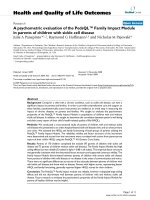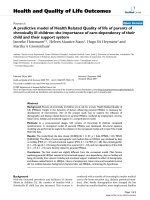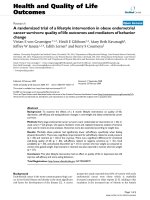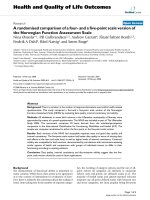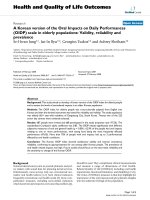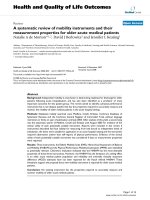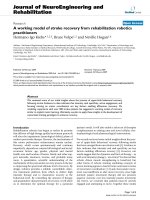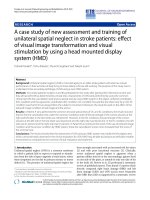báo cáo hóa học: " A predictive model of Health Related Quality of life of parents of chronically ill children: the importance of care-dependency of their child and their support system" docx
Bạn đang xem bản rút gọn của tài liệu. Xem và tải ngay bản đầy đủ của tài liệu tại đây (747.71 KB, 9 trang )
BioMed Central
Page 1 of 9
(page number not for citation purposes)
Health and Quality of Life Outcomes
Open Access
Research
A predictive model of Health Related Quality of life of parents of
chronically ill children: the importance of care-dependency of their
child and their support system
Janneke Hatzmann*
1
, Heleen Maurice-Stam
1
, Hugo SA Heymans
2
and
Martha A Grootenhuis
1
Address:
1
Psycho Social Department, Emma Children's Hospital, Academic Medical Center (AMC), University of Amsterdam, Amsterdam, The
Netherlands and
2
Department of Pediatrics, Emma Children's Hospital, AMC; University of Amsterdam, The Netherlands
Email: Janneke Hatzmann* - ; Heleen Maurice-Stam - ;
Hugo SA Heymans - ; Martha A Grootenhuis -
* Corresponding author
Abstract
Background: Parents of chronically ill children are at risk for a lower Health Related Quality of
Life (HRQoL). Insight in the dynamics of factors influencing parental HRQoL is necessary for
development of interventions. Aim of the present study was to explore the influence of
demographic and disease related factors on parental HRQoL, mediated by employment, income,
leisure time, holiday and emotional support in a comprehensive model.
Methods: In a cross-sectional design, 543 parents of chronically ill children completed
questionnaires. A conceptual model of parental HRQoL was developed. Structural equation
modeling was performed to explore the relations in the conceptual model, and to test if the model
fitted the data.
Results: The model fitted the data closely (CHISQ(14) = 11.37, p = 0.66; RMSEA = 0.0, 90%CI
[0.00;0.034]. The effect of socio-demographic and medical data on HRQoL was mediated by days
on holiday (MCS: β = .21) and emotional support (PCS: β = .14; MCS: β = .28). Also, female gender
(β = 10), age (β = .10), being chronically ill as a parent (β = 34), and care dependency of the child
(β = 14; β = 15) were directly related to parental HRQoL.
Conclusion: The final model was slightly different from the conceptual model. Main factors
explaining parental HRQoL seemed to be emotional support, care dependency, days on holiday and
being chronically ill as a parent. Holiday and emotional support mediated the effect of demographic
and disease-related factors on HRQoL. Hours of employment, leisure time and household income
did not mediate between background characteristics and HRQoL, contrasting the hypotheses.
Background
With the increased prevalence and incidence of chronic
illness in children [1], the number of families with a
chronically ill child has also increased. This increase is
combined with a transfer of increasingly complex medical
care to the home-situation (e.g. dialysis, parenteral nutri-
tion). Also, family demographics have changed the last
decades into smaller families, more single-parent families
Published: 28 July 2009
Health and Quality of Life Outcomes 2009, 7:72 doi:10.1186/1477-7525-7-72
Received: 2 December 2008
Accepted: 28 July 2009
This article is available from: />© 2009 Hatzmann et al; licensee BioMed Central Ltd.
This is an Open Access article distributed under the terms of the Creative Commons Attribution License ( />),
which permits unrestricted use, distribution, and reproduction in any medium, provided the original work is properly cited.
Health and Quality of Life Outcomes 2009, 7:72 />Page 2 of 9
(page number not for citation purposes)
and mothers more often are employed [2]. These changes
stress the need for a better understanding of the conse-
quences for families caring for a chronically ill child. Car-
egiving demands can be extensive, and may lead to
adverse psychosocial consequences for parents.
In a previous report we have shown that almost half of the
parents of chronically ill children are at risk for an
impaired Health Related Quality of Life (HRQoL) [3], par-
ticularly concerning vitality, sleep, daily activities, social
functioning and depressive emotions. Other studies have
also found similar results [4-6]. It is important to under-
stand the dynamics of parental HRQoL, as parental men-
tal functioning is known to influence their children's
health and adjustment [7,8]. Furthermore, it contributes
to the development of interventions to improve parental
HRQoL. Up to now, most studies explored direct predic-
tors of parental well-being and HRQoL, and positive asso-
ciations were found with higher socio-economic status,
coping style, few child behavior problems, less care giving
demands, more social support, and an older age [4,9-11].
In addition to these direct associations, different concep-
tual frameworks have been developed in which demo-
graphic, medical and social variables not only directly but
also indirectly influence health and well-being [10,12-
14]. To our knowledge, most models address adaptation
to illness in disease populations in children or adults, and
only few models focus on parental well-being [11,14,15].
Raina et al, and King et al. developed and tested concep-
tual models of caregiver process and caregiver burden
[10,11,14] including socioeconomic status, child charac-
teristics, caregiver strain, psychosocial and coping factors.
In line with these models, we suppose that HRQoL of par-
ents of chronically ill children is influenced by demo-
graphic, disease related, and social factors, and that the
influence these factors have is a dynamic process. With
respect to social factors, parents of chronically ill children
are known with lower employment rates and reduced lei-
sure time activities compared to parents of healthy chil-
dren [16,17]. Employment is related to parental well-
being, Warfield [18] found that having a satisfying job
reduces parental stress levels and Thyen et al [19] found
worse mental health in unemployed mothers. The aim of
the present study was to extend the literature by including
these social variables in a comprehensive model explain-
ing parental HRQoL. Therefore we constructed a model in
which we described the influence of demographic and dis-
ease related variables on parental HRQoL, mediated by
employment, leisure time, income, holiday and emo-
tional support (Figure 1). We hypothesized that demo-
graphic and disease related characteristics (background)
influenced employment, leisure time, income, holiday
and emotional support (mediators). And that these medi-
ators influenced caregiver mental and physical Health
Related Quality of Life (HRQoL). We also hypothesized
Conceptual model of demographic, disease related and social factors influencing HRQOLFigure 1
Conceptual model of demographic, disease related and social factors influencing HRQOL.
Health and Quality of Life Outcomes 2009, 7:72 />Page 3 of 9
(page number not for citation purposes)
that age, gender and having a chronic illness themselves
influenced HRQoL directly. The model of parental
HRQoL was explored using structural equation modeling.
Methods
Participants and procedure
Parents of chronically ill children participated in this
study, named the Care-project. Chronic illness in child-
hood was defined according to Mokkink et al. [20,21]
using the following criteria: the disease occurs in children
aged 0–18 years, the diagnosis is based on medical scien-
tific knowledge, is not (yet) curable and exists for at least
three months, or will probably endure longer, or at least
three disease episodes have occurred the last year. Accord-
ing to the definition we selected ten different chronic dis-
eases in childhood: asthma, diabetes, Down syndrome,
Duchenne muscular dystrophy, end stage renal disease,
metabolic diseases, profound multiple handicaps, sickle
cell disease, spina bifida, and survivors of a brain tumor.
Inclusion criteria were: [1] the chronically ill children
were aged between 1–19 years, [2] were diagnosed >1 year
before inclusion in the study, [3] the children lived at
home, [4] parents were able to fill out the questionnaire
in Dutch or English.
Between January 2006 and September 2007 parents of
chronically ill children were invited to participate in the
Care project in the Emma Children's Hospital/AMC in
Amsterdam, The Netherlands, and through patient organ-
izations. Parents received an introductory letter explain-
ing the aim of the study and asking their participation.
Parents decided themselves whether the mother or the
father completed the questionnaire. The letter was accom-
panied by the questionnaire, an informed consent form
and a stamped self-addressed envelope. Each family
received one questionnaire, which was completed at
home. The specific procedure for each disease group is
described in Hatzmann et al [3]. The study was approved
by the Medical Ethics Committee of the Academic Medical
Center Amsterdam.
Measurement
A self report questionnaire was developed for the Care
project, including an existing HRQoL questionnaire, and
questions regarding demographics, education, employ-
ment, child care, additional burden in the family (e.g.
chronic illness of parents), use of health care services, lei-
sure activities, and characteristics of the chronically ill
child. Several questions were adapted from other studies
[22-25]. The questionnaire was pre-tested with 15 parents
of chronically ill children who met the inclusion criteria.
Based on their suggestions, modifications were made to
improve the survey's content and clarity. The question-
naire was also available in English, translated into English
by a professional translator.
Background variables: Demographic and disease related
variables
Demographic variables included parental gender, educa-
tional level (low, intermediate, high), having a partner,
country of birth (in The Netherlands, elsewhere), chronic
illness in respondent themselves (y/n), chronic illness in
their partner (y/n), age (parent and child), and number of
children in the family. Disease related variables included
parent report about disease development in their child in
the previous year (progressive, improving, varying, sta-
ble), time since diagnosis (years), and dependency on
daily care, defined as the number of life domains on
which the child needs care (physical, mobility, eating &
drinking, medication use, coping with devices, entertain-
ing, contact with other children, education). This scale
ranges from 0–8, where 0 indicates the child doesn't need
support on the above mentioned domains, and score 8
indicates the child needs support on all domains.
Mediating variables: work, income, leisure time, holiday
and emotional support (social factors)
Mediating factors in our model were employment (hours
per week), net household income (euro per month),
hours per week spent doing leisure activities (sports, hob-
bies), holiday leave (number of days families went on
holiday the last year), and emotional support (emotional
support derived from partner, family, friends or neigh-
bors, scored on 3-point scale: 0 = no support, 1 = more or
less 2 = good support). The scale emotional support
ranges from 0–8, where 0 indicates no support and 8 indi-
cates good support.
Outcome variable: HRQoL
HRQoL was assessed with the 'TNO-AZL Questionnaire
for Adult's Health related Quality of life' (TAAQOL) [26].
The questionnaire measures health status problems
weighted by the impact of problems on well-being on 12
multi-item scales: gross and fine motor functioning, cog-
nitive functioning, sleep, pain, social functioning, daily
activities, sexuality, vitality, positive emotions, depressive
emotions and aggressiveness. Each item consists of two
parts: the first part assesses the prevalence of a health
problem or limitation in the past month, the second part
the emotional response to the health problem or limita-
tion. Answers were scored on 4 point scales. A single score
is attributed to each combination of an item assessing the
prevalence of a problem or limitation and the correspond-
ing emotional response. The scales vitality, positive emo-
tions, depressive emotions and aggressiveness only assess
the occurrence of the feelings in the past month. Higher
scores indicate a better HRQoL. The psychometric proper-
ties, validity and reliability, of the TAAQOL were satisfac-
tory [26]. Overall physical and overall mental HRQoL
were assessed by aggregation of all TAAQoL scale scores
according to the algorithm described by Ware et al [27]
Health and Quality of Life Outcomes 2009, 7:72 />Page 4 of 9
(page number not for citation purposes)
which lead to the so-called Physical Component Score
(PCS) and Mental Component Score (MCS). The relative
contribution of each TAAQoL scale to MCS and PCS was
derived from principal components analysis, non-orthog-
onal rotation (Oblimin), based on the assumption that
physical and mental HRQoL are interdependent.
Statistical analysis
First, HRQoL scales were constructed and missing data
were imputed based on the guidelines of the TAAQOL. In
calculation of the scale scores one missing combined-item
score was allowed for, the missing score is replaced by the
mean value of the non-missing item scores. In addition,
missing HRQoL outcomes were handled through the
Expectation-Maximization estimation method (SPSS
16.0).
Structural Equation Modeling (SEM), using LISREL 8.30,
was performed to investigate the relationships among the
variables in the conceptual model and to test whether the
conceptual model fitted the data, using the correlation
matrix. Standard SEM requirements of data to be continu-
ous en multivariate normal distributed were checked as
follows. First the distributions of the variables were
inspected. Variables at the first level (demographic and
medical variables) were dichotomised if necessary, e.g.
educational level and disease development. The variables
at the second level were inspected carefully and if neces-
sary outliers were recoded, e.g. very high income scores
were recoded to the highest income that was acceptable
considering a normal distribution. The distribution of the
dependent variables at the third level (HRQoL outcomes)
appeared to be acceptable. After that, several regression
analyses were performed (level 2 predicted by level 1,
level 3 predicted by level 1 and 2) to check assumptions.
We did not find any serious violation.
In SEM the covariance structure that follows from the pro-
posed model is fitted to the observed covariances [28].
The maximum likelihood estimate method yields esti-
mates of the regression coefficients in the model, standard
errors, and a χ
2
-test of overall goodness-of-fit [29]. An
alternative fit measure is the root mean square error of
approximation (RMSEA). According to a generally
accepted rule of thumb [30], RMSEA values lower than
0.08 indicate satisfactory fit, and values lower than 0.05
indicate close fit. In addition to overall goodness-of-fit,
component fit was evaluated by inspecting standardized
discrepancies between observed and expected correla-
tions, and LISREL's modification indices [29]. We used a
significance level of p < 0.05 for the regression coeffi-
cients. Standardized regression coefficients of 0.1 were
considered small, 0.3 medium and 0.5 large [31]. For
binary coded predictor variables, regression coefficients of
0.2 can be considered small, 0.5 medium and 0.8 large.
Results
Participants
A total of 1106 parents of chronically ill children from ten
different diagnosis groups were asked to participate in the
Care project, of which 580 (52%) completed the Care-
questionnaire. The response for each diagnosis group is
described in Hatzmann et al [3]. After estimation of miss-
ing data, the full HRQoL data of 543 (49%) parents was
available for analysis. Non-responders did not differ from
responders (p < 0.1) with respect to the age and gender of
the children, except for the children with asthma and
sickle cell disease, with both more boys in the non-
responders group (p < 0.1).
The mean age of the caregivers was 42 (SD: 6.5) years, of
which 83% was female (Table 1). Most respondents had a
partner (86%) and were born in the Netherlands (82%).
Fourteen percent of the respondents had a chronic illness
themselves, and 10% of their partners. Families had on
average 2.3 (SD: 0.9) children. The chronically ill children
were on average 10.0 (SD 4.4) years, and mean time since
diagnosis was 7.9 (SD 4.2) years (Table 2).
Model fit
The conceptual model (Figure 1) was fitted to the correla-
tion matrix. The CHISQ measure of overall goodness-of-
fit was 36.92 (CHISQ(18), p = 0.0054) and the hypothe-
ses of exact fit was rejected. The RMSEA was 0.044, and the
90% confidence interval (CI) ranged from 0.023 to 0.064,
which indicated that the fit was satisfactory. Inspection of
component fit indices indicated two possible modifica-
tions. The modification indices suggested an additional
direct effect of "care dependency" and "worsening disease
development" on HRQoL. These modifications were
added to the model, resulting in a modified model with
close fit: CHISQ(14) = 8.70, p = 0.085; RMSEA = 0.0, 90%
CI [0.00;0.023]; CFI = 1.00. The modified model
explained 21% of the variance in PCS and 20% of the var-
iance in MCS. Figure 2 gives a graphical display of the
modified model, and Additional file 1; Table S1 gives the
parameter estimates.
The first part (1) of Additional file 1; Table S1 presents the
effects of demographic and disease related variables
(background characteristics) on the mediating factors, the
second part (2) contains the direct effects of the back-
ground characteristics on HRQoL, and the third part (3)
contains the effects of the mediating factors on HRQoL.
The total effect of a variable on HRQoL can be calculated
using the direct and indirect pathways in the modified
model, as the following example illustrates. Additional
file 1; Table S1 shows the direct and indirect effects of
"care dependency" on MCS. First, an increase of one
standard deviation on "care dependency" is associated
with a statistically significant decrease of 0.15 standard
Health and Quality of Life Outcomes 2009, 7:72 />Page 5 of 9
(page number not for citation purposes)
deviation in MCS (direct effect). Second, an increase of
one standard deviation on "care dependency" is associ-
ated with a statistically significant decrease of 0.13 stand-
ard deviation in "holiday", while the effect of "holiday"
on MCS was 0.21. So the statistically significant effects of
"care dependency" on MCS can be calculated as follows: -
0.15 + (-0.13 × 0.21) = -0.18. Apart from that, the other
direct and indirect effects of "care dependency" on MCS
were small and non-significant, so that the total effect (-
0.20) remains small.
Effects of the demographic and disease characteristics
All the significant regression coefficients of the demo-
graphic and disease related variables were small to
medium [31], ranging from β = 0.08 to β = 0.38. The
demographic variables affected the mediating factors
Table 1: Characteristics of observed variables of caregivers and their chronically ill children
Parents chronically ill children Sample size
Demographic Variables n (%)
Gender (Female) 452 (83) 542
Educational level
1
535
Lower 140 (26)
Intermediate 220 (41)
Higher 175 (33)
Married/Partner 469 (87) 541
Born in the Netherlands 445 (82) 543
Respondent chronically ill 77 (14) 542
Partner Chronically ill 52 (10) 542
Mean (sd)
Age Parent Years (SD) 42.0 (6.5) 540
Children per family 2.3 (0.9) 533
Age child 10.0 (4.4) 532
Disease related variables
Care Dependency * 3.2 (2.5) 540
Time since diagnosis 7.9 (4.2) 496
Disease Development n (%) 511
Progressive 93 (18)
Improving 134 (26)
Varying 120 (23)
Stable 164 (32)
Social participation Mean (SD)
Hours of work/week 15.38 (13.89) 497
Monthly family income (euro) 2504 (1171) 480
Leisure time (hours) 4.9 (5.7) 539
Holiday (days/year) 19.3 (11.6) 476
Emotional support ** 4.8 (2.0) 529
1
Highest level completed. Lower: Primary education, Lower and Middle General Secondary education; Intermediate: Middle Vocational education,
Higher Secondary education, Pre-university education; Higher: Higher Vocational Education, University
* scale 0–8 (high score representing high dependency)
** scale 0–8 (high score representing good support)
Table 2: Characteristics of the chronically ill children
Age (mean, sd) 10.0 (4.4)
Time since diagnosis in years (mean, sd) 7.9 (4.2)
Diagnosis: n (%)
Asthma 90 (17)
Survivors of brain tumor 38 (7)
Diabetes 24 (4)
Down syndrome 101 (19)
Duchenne muscular dystrophy 57 (10)
End stage renal disease 21 (5)
Metabolic diseases 118 (22)
Profound complex handicap 13 (2)
Sickle cell disease 61 (11)
Spina Bifida 20 (4)
Health and Quality of Life Outcomes 2009, 7:72 />Page 6 of 9
(page number not for citation purposes)
more strongly than the disease related variables, specifi-
cally: gender, educational level, country of birth, and liv-
ing with a partner appeared to correlate with
employment, leisure time, income, holiday and emo-
tional support.
Several direct and indirect effects of demographic and dis-
ease related variables on HRQoL were found. Being
female had a negative (direct) as well as positive (indirect,
via "emotional support") effect on PCS. High educational
level, living with a partner and being born in the Nether-
lands were correlated with better HRQoL, indirectly via
"emotional support" (PCS and MCS) and "holiday"
(MCS). Having a partner with a chronic disease is also
indirectly associated with better MCS via "holiday".
On the contrary, suffering from a chronic disease by the
parent and greater care dependency had a negative impact
on HRQoL. More specific, parents who suffered from a
chronic disease themselves or who reported greater care
dependency, experienced worse PCS and MCS, directly
and/or indirectly, via "holiday" and "emotional support".
Effects of the mediating factors (work, income, leisure
time, holiday and emotional support)
A few significant effects of mediating factors on HRQoL
were found. The effects were rather small, ranging from β
= 0.14 to β = 0.28. First, parents who experienced more
emotional support reported better PCS as well as better
MCS. Second, parents who went more days on holiday
reported higher levels of MCS.
Discussion
In the present study, a model explaining direct and indi-
rect associations of demographic, disease related and
social factors with the HRQoL of parents of chronically ill
children was tested. In our model, parental HRQoL is
directly associated with gender, parental age, having a
chronic illness as a parent, care-dependency of the child,
emotional support, and number of day's parents went on
holiday in the past year. Socio-demographic variables
mainly relate to HRQoL indirectly through holiday and
emotional support. When looked at the size of the (signif-
icant) effects, dependency of the child, chronic illness of
the parent, days on holiday, and the support system seem
to be the main factors predicting parental HRQoL.
The final model fitted the data closely, but appeared to be
slightly different from our conceptual model. As we
hypothesized, demographic variables did influence work
per week, family income and leisure time, and disease
related variables influenced leisure time and holiday. But
work, income and leisure time did not significantly medi-
ate between demographic & disease related variables and
HRQoL in the final model. Although several studies
showed that parents of children with a chronic disease
work fewer hours and spend fewer hours doing leisure
activities [17,19,32], we have not found evidence that this
Modified final model of predicting parental HRQOL of caregivers of chronically ill childrenFigure 2
Modified final model of predicting parental HRQOL of caregivers of chronically ill children.
Health and Quality of Life Outcomes 2009, 7:72 />Page 7 of 9
(page number not for citation purposes)
influences HRQoL. A potential reason for the lack of effect
is that not the amount, but satisfaction with work and lei-
sure time is more important in explaining HRQoL [18].
Within the disease related variables, care-dependency was
most associated with HRQoL. It influenced HRQoL both
directly and indirectly through days on holiday per year.
An increase in dependency of children on others for care,
leads to a lower HRQoL in their parents. The importance
of care dependency was also seen in other studies [11,17].
Unfortunately we do not know whether it is the emo-
tional aspect of having a dependent child, or whether this
is caused by the extra caregiving demands. A potential way
to diminish the extra caregiving demands is making use of
respite care. Drawn up from the literature, the effect of res-
pite care on well-being of parents of chronically ill chil-
dren is however not easily evaluated [33-36]. In caregivers
in general (not only parents of ill children), some evi-
dence regarding the effectiveness of respite care is found,
and these caregivers expected that respite care would
increase their well-being [35]. This implies that a good
family support system or official support in terms of res-
pite care would be able to improve caregiver HRQoL.
However, more evidence within the population of parents
of chronically ill children is needed.
In addition to the above described positive effect of prac-
tical support, emotional support has a positive influence
on parental HRQoL. Emotional support was measured as
an evaluation of the quality of support (no support, mod-
erate or good emotional support) from partner, family,
friends and neighbours. Other research also shows the
importance of a support network for parental emotional
well-being [37,38]. Parents getting the best emotional
support were mothers with high education and a partner,
born in the Netherlands. Hence, parents at risk for less
support, and thus a lower HRQoL are single parents with
lower education, not born in the Netherlands, and parents
who are chronically ill themselves. In terms of prevention,
parents should be stimulated to maintain and invest in
their social network.
The number of days per year families went on holiday pre-
dicted the mental aspect of HRQoL positively. The present
study does not distinguish between parents going on a
holiday alone or with their children. Parents who went on
holiday more often had a higher educational level, a part-
ner and were born in The Netherlands. On the contrary,
parents who were chronically ill themselves and parents
whose children were more dependent on care, went less
days on holiday per year. This group of parents already
has a lower HRQoL, in addition, they also are less able to
benefit from going on a holiday. More research is needed
regarding if and how these parents can benefit from going
on a holiday despite the disease related limitations.
The conceptual model used in this study only included
mediating effects, while moderation was not tested. In our
model, especially emotional support would theoretically
be a plausible moderator of the effect of background char-
acteristics on HRQoL. Despite plausibility, moderating
effects of emotional support were not found. This is in
line with a study by Quittner et al [39], who found evi-
dence for a mediating effect and not for a moderating
effect of social support on chronic parenting stress.
These results should be considered in light of a number of
limitations. First, the response rate was 52%, with a
majority of relatively good educated, Dutch, two-parent
families. Therefore, our results are not representative for
the entire group of parents of chronically ill children.
Future research in other socio-demographic subgroups is
necessary in order to provide adequate data and interven-
tions for all parents. Second, although our model fitted
the data closely, it explained only 21% of the variance of
mental HRQoL and 20% of physical HRQoL, which
might partly be due to the fact that we did not include fac-
tors as coping and family function. Other studies show
that coping is an important variable in adaptation to
chronic illness [13,40,41], and family function and child
behavior also are associated with caregiver function
[11,14]. Our model on the other hand shows the signifi-
cance of care dependency and emotional support on
parental HRQoL. Third, methodological limitations are
the use of parent report and a single informant, which
may lead to overestimation of the effects due to shared
method variance. Also, the cross-sectional nature of the
study does not allow inferences about causality. Our
model should therefore be considered an explorative
model, describing directions of associations, but not con-
firming causality. Fourth, using summary scores of
HRQoL as a dependent variable had the advantage of its
density and distribution. A disadvantage is the loss of
detail in the analyses of HRQoL. The parents in the
present study reported several problems on social and
emotional domains[3], that are now summarized in men-
tal and physical components of HRQoL. It is therefore
important to realize where the summary scales are based
on. Notwithstanding these limitations, the results of the
present study give more insight in the dynamics of paren-
tal HRQoL.
Conclusion
The final model fitted the data closely. Socio-demo-
graphic characteristics mainly influenced HRQoL indi-
rectly by holiday and emotional support. Care-
dependency and chronic illness of the parent had both
direct and indirect negative effects on HRQoL. The signif-
icant effects were all small, meaning that we should be
careful drawing conclusions based on these data.
Health and Quality of Life Outcomes 2009, 7:72 />Page 8 of 9
(page number not for citation purposes)
Implications for future research and clinical practice
Based on the results recommendations for future research
include development of a more specific model with fewer
variables and addition of psychosocial factors. Both medi-
ating and moderating effects of these psychosocial varia-
bles should be considered. Also, future research should
address quality of work and leisure time in addition to
measures of quantity.
In clinical practice, insight in the factors that affect
HRQoL may help health care providers to be aware of par-
ents vulnerable for problems. The child and its family
should be the focus of the professional. Also, profession-
als should be made aware of the consequences of care for
parents during their training. Furthermore, they should be
trained in how to detect and refer (e.g. to social worker of
psychologist) parents who need professional support.
Early detection and referral of parents at risk for impaired
HRQoL could be achieved by using PRO's (Patient/Parent
Reported Outcomes) in both outpatient and clinical set-
tings [42]. For now, professionals should be aware of par-
ents with lower socio-economic status, who are
chronically ill themselves and have children with higher
levels of care-dependency. Interventions should be
directed at empowering parents to set up an adequate sup-
port system in order to derive emotional support and
share the care for their children.
Competing interests
The authors declare that they have no competing interests.
Authors' contributions
JH designed the study, collected data, analyzed and inter-
preted the data and drafted the manuscript. HM analyzed
and interpreted data, drafted and revised the manuscript.
HH supervised design and execution of the study and
revised the manuscript. MG designed and supervised exe-
cution of the study, analyzed and interpreted data and
revised the manuscript. All authors read and approved the
manuscript.
Additional material
Acknowledgements
The present study was partly funded by the Dutch Ministry of Social Affairs
and Employment.
References
1. Perrin JM, Bloom SR, Gortmaker SL: The increase of childhood
chronic conditions in the United States. JAMA 2007,
297(24):2755-9.
2. Lilly MB, Laporte A, Coyte PC: Labor market work and home
care's unpaid caregivers: a systematic review of labor force
participation rates, predictors of labor market withdrawal,
and hours of work. Milbank Q 2007, 85(4):641-90.
3. Hatzmann J, Heymans HS, Ferrer IC, van Praag BM, Grootenhuis MA:
Hidden Consequences of Success in Pediatrics: Parental
Health-Related Quality of Life – Results From the Care
Project. Pediatrics 2008, 122(5):e1030-e1038.
4. Boyer F, Drame M, Morrone I, Novella JL: Factors relating to
carer burden for families of persons with muscular dystro-
phy. J Rehabil Med 2006, 38(5):309-15.
5. Murphy NA, Christian B, Caplin DA, Young PC: The health of car-
egivers for children with disabilities: caregiver perspectives.
Child Care Health Dev 2007, 33(2):180-7.
6. Lawoko S, Soares JJ: Quality of life among parents of children
with congenital heart disease, parents of children with other
diseases and parents of healthy children. Qual Life Res 2003,
12(6):655-66.
7. Prince M, Patel V, Saxena S, Maj M, Maselko J, Phillips MR, Rahman A:
No health without mental health. Lancet 2007,
370(9590):859-77.
8. Friedman D, Holmbeck GN, Jandasek B, Zukerman J, Abad M: Par-
ent functioning in families of preadolescents with spina bif-
ida: longitudinal implications for child adjustment. J Fam
Psychol 2004, 18(4):609-19.
9. Vermaes IP, Janssens JM, Bosman AM, Gerris JR: Parents' psycho-
logical adjustment in families of children with spina bifida: a
meta-analysis. BMC Pediatr 2005, 5:32.
10. Raina P, O'Donnell M, Schwellnus H, Rosenbaum P, King G, Brehaut
J, Russell D, Swinton M, King S, Wong M, Walter SD, Wood E: Car-
egiving process and caregiver burden: conceptual models to
guide research and practice. BMC Pediatr 2004, 4:1.
11. Raina P, O'Donnell M, Rosenbaum P, Brehaut J, Walter SD, Russell D,
Swinton M, Zhu B, Wood E: The health and well-being of car-
egivers of children with cerebral palsy. Pediatrics 2005,
115(6):e626-e636.
12. Wilson LS, Moskowitz JT, Acree M, Heyman MB, Harmatz P, Fer-
rando SJ, Folkman S: The economic burden of home care for
children with HIV and other chronic illnesses. Am J Public
Health 2005, 95(8):1445-52.
13. Wallander JL, Varni JW: Effects of pediatric chronic physical dis-
orders on child and family adjustment. J Child Psychol Psychiatry
1998, 39(1):29-46.
14. King G, King S, Rodenbaum p, Goffin R: Family-Centered Car-
egiving and Well-Being of Parents of Children With Disabil-
ities: Linking Process With Outcome. Journal of Pediatric
Psychology 1999, 24(1):41-53.
15. Klassen A, Raina P, Reineking S, Dix D, Pritchard S, O'Donnell M:
Developing a literature base to understand the caregiving
experience of parents of children with cancer: a systematic
review of factors related to parental health and well-being.
Support Care Cancer 2007, 15(7):807-18.
16. Kirk S: Families' experiences of caring at home for a technol-
ogy-dependent child: a review of the literature. Child Care
Health Dev 1998, 24(2):101-14.
17. Kuhlthau KA, Perrin JM: Child health status and parental
employment. Arch Pediatr Adolesc Med 2001, 155(12):1346-50.
18. Warfield ME: Employment, parenting, and well-being among
mothers of children with disabilities. Ment Retard 2001,
39(4):297-309.
19. Thyen U, Kuhlthau K, Perrin JM: Employment, child care, and
mental health of mothers caring for children assisted by
technology. Pediatrics 1999, 103(6 Pt 1):1235-42.
20. Mokkink LB, Lee JH van der, Grootenhuis MA, Offringa M, Heymans
HSA, The Dutch National Consensus Committe 'Chronic diseases
and Health Conditions in Childhood: Defining chronic disease
Additional file 1
Predictive model of Health-related Quality of life in parents of chron-
ically ill children: standardized Regression Coefficients and Percent-
age of Explained Variance of the Modified Model. Table showing the
Predictive model of Health-related Quality of life in parents of chronically
ill children: standardized Regression Coefficients and Percentage of
explained variance of the modified model. The model explains 21% and
20% of the variance of PCS and MCS, respectively.
Click here for file
[ />7525-7-72-S1.doc]
Publish with BioMed Central and every
scientist can read your work free of charge
"BioMed Central will be the most significant development for
disseminating the results of biomedical research in our lifetime."
Sir Paul Nurse, Cancer Research UK
Your research papers will be:
available free of charge to the entire biomedical community
peer reviewed and published immediately upon acceptance
cited in PubMed and archived on PubMed Central
yours — you keep the copyright
Submit your manuscript here:
/>BioMedcentral
Health and Quality of Life Outcomes 2009, 7:72 />Page 9 of 9
(page number not for citation purposes)
and health conditions in childhood (0–18 years): national
consesus in the Netherlands. European Journal of Pediatrics 2008,
167(12):1441-7.
21. Mokkink LB, Lee JH van der, Grootenhuis MA, Offringa M, van Praag
BMS, Heymans HSA: Extent and Consequences of Chronic
Conditions in Children [in Dutch]. Amsterdam, The Nether-
lands: Emma Childrens Hospital, AMC; 2006.
22. van Acker MB: Health measurement 2004, of inhabitants of 19, years and
older of the Gooi-en Vechtstreek. [In Dutch] GGD Gooi en Vechtstreek,
Bussum; 2005.
23. Van Agt Hme, Sronks K, Mackenbach JP: The financial situation of chron-
ically ill patients. Final report of a longitudinal study of the financial situation
of chronically ill patients [In Dutch] Rotterdam: Instituut Maatschappeli-
jke Gezondheidszorg, Erasmus Universiteit 3; 1996.
24. Snyder DK: Marital Satisfaction Inventory Manual Western Psychologi-
cal Services, Los Angeles; 1981.
25. Kars M, Duijnstee M, Grypdonk M: Learing to navigate. Supporting par-
ents of chronically ill children: for nurses. [In Dutch] Elsevier gezond-
heidszorg, Maarssen; 2005.
26. Bruil J, Fekkes T, Vogels T, Verrips GHW: TAAQOL Manual. Lei-
den Center for Child Health and Pediatrics LUMC-TNO 2004.
27. Ware JE, Kosinski M: Interpreting SF-36 summary health meas-
ures: a response. Qual Life Res 2001, 10(5):405-13.
28. Jöreskog KG, Sörbom D: LISREL 8, Users Guide. Chicago IL: Sci-
entific Software International, INC; 1996.
29. Bollen KA: Structural equations with latent variables. New
York: Wiley; 1989.
30. Browne MW, Cudeck R: Alternative ways of assessing model
fit. Sociological Methods Research 1992, 21:230-58.
31. Cohen J: Statistical power analysis for the behavioral sciences.
New York: Academy Press; 1988.
32. Brandon P: Time away from "smelling the roses": where do
mothers raising children with disabilities find the time to
work? Soc Sci Med 2007, 65(4):667-79.
33. Chou YC, Tzou PY, Pu CY, Kroger T, Lee WP: Respite care as a
community care service: factors associated with the effects
on family carers of adults with intellectual disability in Tai-
wan. J Intellect Dev Disabil 2008, 33(1):12-21.
34. Sherman BR: Impact of home-based respite care on families of
children with chronic illnesses.
Child Health Care 1995,
24(1):33-45.
35. van EJ, de GG, Brouwer W: Give me a break! Informal caregiver
attitudes towards respite care. Health Policy 2008, 88(1):73-87.
36. Neufeld SM, Query B, Drummond JE: Respite care users who
have children with chronic conditions: are they getting a
break? J Pediatr Nurs 2001, 16(4):234-44.
37. Garwick AW, Patterson JM, Bennett FC, Blum RW: Parents' per-
ceptions of helpful vs unhelpful types of support in managing
the care of preadolescents with chronic conditions. Arch Pedi-
atr Adolesc Med 1998, 152(7):665-71.
38. Melnyk BM, Feinstein NF, Moldenhouer Z, Small L: Coping in par-
ents of children who are chronically ill: strategies for assess-
ment and intervention. Pediatr Nurs 2001, 27(6):548-58.
39. Quittner AL, Glueckauf RL, Jackson DN: Chronic parenting
stress: moderating versus mediating effects of social sup-
port. J Pers Soc Psychol 1990, 59(6):1266-78.
40. Maurice-Stam H, Oort FJ, Last BF, Grootenhuis MA: Emotional
functioning of parents of children with cancer: the first five
years of continuous remission after the end of treatment.
Psychooncology 2008, 17(5):448-59.
41. Wong MG, Heriot SA: Parents of children with cystic fibrosis:
how they hope, cope and despair. Child Care Health Dev 2008,
34(3):344-54.
42. Varni JW, Burwinkle TM, Lane MM: Health-related quality of life
measurement in pediatric clinical practice: an appraisal and
precept for future research and application. Health Qual Life
Outcomes 2005, 3:34.

